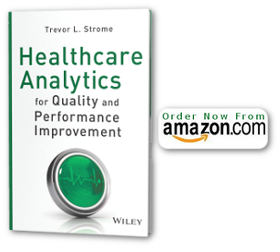Information overload in clinical settings
The term information overload refers to the “difficulty a person can have understanding an issue and making decisions that can be caused by the presence of too much information” (see citation from Wikipedia). An article by Sean M. Thomas, MD, and David J. Rosenman, MD in The Hospitalist suggest that clinicians must be proficient at sifting and prioritizing critical clinical information. Thomas and Rosenman also state that, due to the increasing volume of data available, special attention must be paid to what information is made available, and what data display and visualization techniques are used.
Is Analytics a cause of, or solution to, information overload?
Analytics are now an invaluable tool in transforming healthcare. Analytics can be used to identify new opportunities for improvement, and can help sustain healthcare transformation changes by ensuring that timely performance metrics are available. Management is able to observe trends, and front-line staff able to modify their own performance, when direct performance information pertaining to processes and workflows is available. This can be achieved through simple reporting of performance made available through posting of data, or making the performance data available on dashboards.
As the number of improvement initiatives grows, the number of metrics to post and monitor may become unwieldy for front-line staff to make sense of. In addition to being bombarded with an ever increasing amount of patient clinical data resulting from computerized Electronic Medical Records (EMRs) and other clinical systems, staff run the risk of being inundated with an unmanageable number of performance metrics to monitor. When this occurs, staff will simply ignore information when it becomes cumbersome and without focus. Simply put – you don’t want drown them with data.
Tips to prevent information from being ignored
Information will be ignored when it is perceived to be of less value than other seemingly higher-value data. To prevent important performance information from being drowned out, there are several common-sense approaches to keep the attention of analytics end-users.
- Ensure information is up-to-date and accurate. Don’t insult front-line staff by wasting their time with information that is out-of-date (or worse, inaccurate). To modify processes and sustain change, real-time and recent information is the key. Showing last month’s stats on Emergency Department visits might be interesting trivia, but it won’t sustain transformation, and it might just contribute to “noise”.
- Present information that is relevant and actionable. Information presented on dashboards (or posted in the unit) needs to relate to the most pressing quality, patient safety, or operational issues being addressed. Furthermore, it needs to suggest a course of action. Trying to change too many things at once (and posting all those metrics) is likely to have the same effect as driving when given competing directions – you’ll end up lost. Focus on the critical few; once change is proven to be sustained, move on to the next priorities.
- Analyze and visualize information appropriately. A quality improvement dashboard is not the place to experiment with obscure or overly sophisticated analysis and visualization techniques. Although perhaps not as “analytically satisfying”, it’s important to keep the analysis and visualization at the level of most of the users of the information. This means perhaps more tables and bar charts than box and whisker plots, but the results will likely be more meaningful for users. (Of course, as the analytic sophistication of the end-users increases, the sophistication of information display should increase accordingly.)
- Engage staff. As the end users of analytics for quality improvement, clinical staff should be engaged for their opinions and feedback about what information would be most useful on a display, and how it should be visualized. When clinical staff are engaged in the development of analytics, it is likely that the end results will better meet the needs of staff, and will better support quality improvement initiatives, than analytic tools developed solely by analysts and managers.
Intelligent and selective application of analytics is key to sustainability
Information can only be effective facilitators of change when it’s the right information available at the right time for the right individual. The tips presented in this article will help sustain healthcare transformation efforts by keeping staff engaged with analytics and prevent important information from being ignored as a result of overloading.

{ 0 comments… add one now }